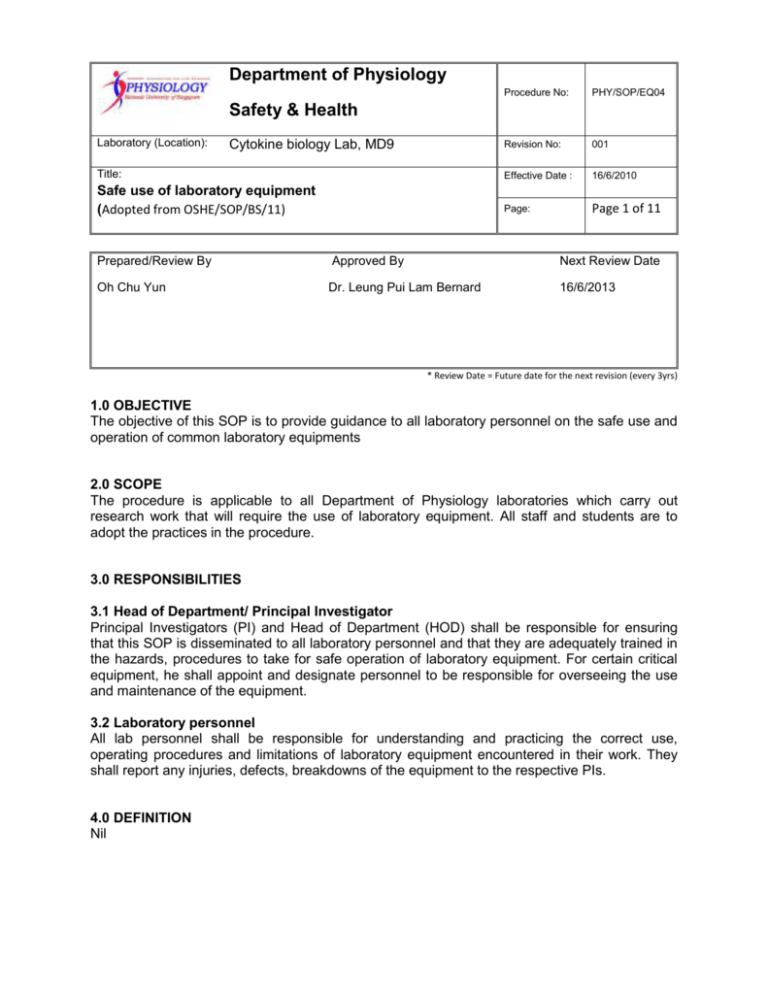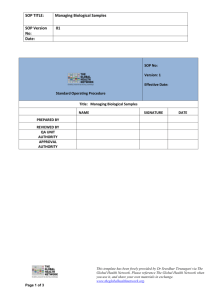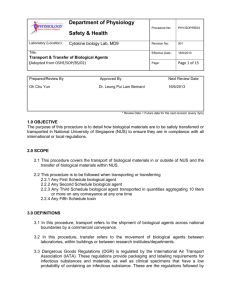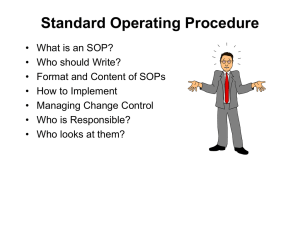Department of Physiology Safety & Health
advertisement

Department of Physiology Procedure No: PHY/SOP/EQ04 Revision No: 001 Title: Effective Date : 16/6/2010 Safe use of laboratory equipment (Adopted from OSHE/SOP/BS/11) Page: Page 1 of 11 Safety & Health Laboratory (Location): Cytokine biology Lab, MD9 Prepared/Review By Approved By Next Review Date Oh Chu Yun Dr. Leung Pui Lam Bernard 16/6/2013 * Review Date = Future date for the next revision (every 3yrs) 1.0 OBJECTIVE The objective of this SOP is to provide guidance to all laboratory personnel on the safe use and operation of common laboratory equipments 2.0 SCOPE The procedure is applicable to all Department of Physiology laboratories which carry out research work that will require the use of laboratory equipment. All staff and students are to adopt the practices in the procedure. 3.0 RESPONSIBILITIES 3.1 Head of Department/ Principal Investigator Principal Investigators (PI) and Head of Department (HOD) shall be responsible for ensuring that this SOP is disseminated to all laboratory personnel and that they are adequately trained in the hazards, procedures to take for safe operation of laboratory equipment. For certain critical equipment, he shall appoint and designate personnel to be responsible for overseeing the use and maintenance of the equipment. 3.2 Laboratory personnel All lab personnel shall be responsible for understanding and practicing the correct use, operating procedures and limitations of laboratory equipment encountered in their work. They shall report any injuries, defects, breakdowns of the equipment to the respective PIs. 4.0 DEFINITION Nil Department of Physiology Procedure No: PHY/SOP/EQ04 Revision No: 001 Title: Effective Date : 16/6/2010 Safe use of laboratory equipment (Adopted from OSHE/SOP/BS/11) Page: Page 2 of 11 Safety & Health Laboratory (Location): Cytokine biology Lab, MD9 5.0 PROCEDURE There is a number of equipment in the lab that requires extra care in their use. It is essential to have adequate training in the use of all equipment before attempting to use it. Do not use any equipment if you have not had training on or are unsure of their use. Commonly used equipment covered in this SOP includes: i) Autoclaves - see SOP (CBL/SOP/05)-“Operation of Autoclaves” ii) Blending, Mixing, Sonicating and Cell Disruption Equipment iii) Bunsen Burners iv) Centriuges - see SOP (CBL/SOP/03)-“Centrifuge Safety” v) Electrophoresis equipment vi) Hot plates, drying ovens, and other heating devices vii) Laboratory Hood/cabinet viii) Lyophilizer/ Freezedryers ix) Microscopes x) Microtomes/Cryostats xi) Pipettes and Pipetting Aids xii) Refrigerators, freezers and cold rooms xiii) Ultra Violet (UV) -emitting equipment xiv) Vacuum Line Chemical Traps and Filters 5.1 Blending, Mixing, Sonicating and Cell Disruption Equipment a. Devices such as blenders, tissue grinders, magnetic mixers, stirrers, sonic cleaning devices, ultrasonic cell disintegrators, and shakers can generate hazardous aerosols. Operate blending, cell disruption, and grinding equipment in a biological safety cabinet when used with infected tissues or materials. b. Ensure that caps, vessels and gaskets for such equipments are in good condition and caps are well-fitting. Aerosols containing infectious materials may escape from between the cap and the vessel as a result of pressure build up in the vessel during operation of the equipment. c. Use plastic, in particular, polytetrafluoroethylene (PTFE) vessels in place of glass as glass may break, releasing infectious material and possibly wounding the operator. d. Sonicators – Sonicators are high-frequency sound generators used to disrupt cells or shear nucleic acids. The two major hazards associated with sonicators are hearing damage caused by high frequency sound and generation of aerosols from the sonication process. – Wear hearing protection while using sonicators. Do not sonicate in a room containing people not wearing ear protection – Shut doors of the room where sonication is taking place. Department of Physiology Procedure No: PHY/SOP/EQ04 Revision No: 001 Title: Effective Date : 16/6/2010 Safe use of laboratory equipment (Adopted from OSHE/SOP/BS/11) Page: Page 3 of 11 Safety & Health Laboratory (Location): Cytokine biology Lab, MD9 – If possible, have the sonicator located in a "sound-proof" cabinet while sonicating. e. Blenders – Do not use domestic (kitchen) blenders. Use safety blenders designed to prevent aerosol formation and leakage from the bottom of the blender bowl. They can also withstand sterilization by autoclaving. – Inspect the rotor for leakage prior to operation. – If the blender is used with infectious material place a towel moistened with an appropriate disinfectant over the top of the blender. – Sterilize the device and residual contents promptly after use; – Avoid using glass blender bowls with infectious material because of the potential for breakage; – After blending, allow the contents to settle for a few minutes before opening the blender bowl f. Tissue grinders – When using glass grinders, hold it in an absorbent material in a gloved hand. Use the safer alternative of plastic (PTFE) grinders if possible. 5.2 Bunsen Burners a. Never leave an open flame unattended. b. It is extremely dangerous to have open flames around flammable materials, such as ethanol, which are often found in biological laboratories. c. Place the Bunsen burner away from combustible materials, papers or chemicals. d. If you smell gas, turn off the gas valve and wait until the gas has fully dissipated before relighting the burner. e. Never use a Bunsen burner inside a biological safety cabinet! The heat generated within the cabinet creates airflow turbulence that may compromise sterility and worker protection. A biological safety cabinet recirculates air within the interior and explosive vapors may build up inside the cabinet. The heat buildup may also damage the HEPA filters. f. Use burners with safety features such as flame monitor, alarm displays, regulated timer, automatic gas cut-off etc. 5.3 Electrophoresis equipment b. Electrophoresis equipment used for agarose gel running, DNA sequencing etc. presents electrical, chemical and/or radiological hazards. c. Most electrophoresis units use very high voltage (approximately 2000 volts) and potentially hazardous current (80 milliamps or more). This high power output has the potential to cause a fatal electrical shock if not properly handled. d. Inspect electrophoresis units and their power supplies routinely to ensure that they are working properly. Inspect buffer tanks for cracks or leaks, exposed connectors, and power supplies for signs of deterioration (e.g. exposed wires, damaged leads etc Department of Physiology Procedure No: PHY/SOP/EQ04 Revision No: 001 Title: Effective Date : 16/6/2010 Safe use of laboratory equipment (Adopted from OSHE/SOP/BS/11) Page: Page 4 of 11 Safety & Health Laboratory (Location): Cytokine biology Lab, MD9 e. Place “Danger—High Voltage” warning signs are in place on the power supply and buffer tanks. f. Practice good housekeeping when locating, or working around or near an electrophoresis unit. Avoid placing the units on grounding points and conductors (e.g., sinks and other water sources or other metal surfaces). Locate the equipment where it will not be easy to knock over or trip on. Always maintain adequate clearance around the apparatus. g. In the event of spills or leaks of electrophoresis buffer, stop the run and clean up the bench top immediately. h. Do not permit leads to dangle below the lab bench. i. Whenever possible, set the power supply on a shelf above the gel box. j. Turn the power supply off before disconnecting both leads from the power supply. k. As with all research, ensure that you are familiar with any associated chemical and radiological hazards and the control measures and precautions required when working with them. 5.4 Hot plates, drying ovens, and other heating devices a. Burns and other injuries can occur when heating devices such as ovens, hotplates and heating mantles are not used properly. b. Never had a sealed container regardless of the type of heating device used. c. Always use the device as intended, especially when used with or near flammable or combustible solvents or materials. Heating devices must be rated /approved for the use and the environment in which it will be used (i.e., flammable or explosive atmospheres, in the presence of combustible dust, etc.) d. Use thermal gloves or tongs to remove items from their heating devices. e. Use protective eyewear when using ovens, hot plates, or other heating devices. f. Drying Ovens – Locate ovens away from potential fuel sources (i.e., common combustible materials like organic solvent storage areas, cardboard and paper etc.) due to their spark potential. – Due to possible formation of explosive mixtures by volatile substances and the air inside an oven, do not use domestic household ovens in the lab. Unlike laboratory ovens, their heating elements (which may become extremely hot) and their temperature controls (which may produce sparks) are not physically separated from their interior atmospheres. – Drying ovens should not be used to dry glassware that has been rinsed with organic solvents. – Do not use mercury thermometers to monitor oven temperatures. Accidental breakage of the thermometer will cause a serious hazard since uncontained mercury will volatilize very rapidly. Department of Physiology Procedure No: PHY/SOP/EQ04 Revision No: 001 Title: Effective Date : 16/6/2010 Safe use of laboratory equipment (Adopted from OSHE/SOP/BS/11) Page: Page 5 of 11 Safety & Health Laboratory (Location): – Cytokine biology Lab, MD9 Volatile materials may be present in sufficient concentration to form explosive mixtures within the oven itself. If they are present, venting the oven to an exhaust system to this hazard. g. Hot Plates/Heated Stir Plates with temperature control devices must be spark-free. If water or other liquid has been spilled onto the element, have the equipment serviced before use. Allow plenty of time for the hot plate to cool before handling. h. Heating devices (such as heating mantles) – Heating devices require autotransformers to control the temperature. When used with auto-transformers, make certain that the auto transformer is properly wired and located. – Unattended heating devices must be protected with overload circuitry and with a temperature-sensing device that will turn the power off in the event of overheating. – When cooling water is used in connection with heating (as in the condenser of a solvent still), it is necessary to have an automatic device to turn off the power when water flow is interrupted. – Always support the heating mantle with a ring to allow air circulation around it to prevent overheating of the exterior of the mantel. Never support a heating mantle with combustible materials. 5.5 Laboratory Hood/cabinet identification and use a. Different types of ventilation systems (hood/ cabinets) are found in laboratories. Each is designed for a specific use and it is important to understand how these systems operate and know their limitations to ensure the operator’s safety. b. Specialized laboratory ventilation systems are designed to offer personnel protection, product protection or both. Systems differ in the direction of the airflow. The use of the incorrect hood/cabinet will put the user at risk of chemical or biological exposure, or may affect research results. c. The most common types of lab hoods/cabinets are summarized here. Correct use and operation of some (e.g. Biosafety cabinets, laminar flow hoods and fume hoods) are detailed in separate SOPs. Department of Physiology Procedure No: PHY/SOP/EQ04 Revision No: 001 Title: Effective Date : 16/6/2010 Safe use of laboratory equipment (Adopted from OSHE/SOP/BS/11) Page: Page 6 of 11 Safety & Health Laboratory (Location): Cytokine biology Lab, MD9 d. Chemical Fume Hoods protect the worker from chemical exposure. Air is pulled into the face of the hood and exits through a stack that exhausts to the outside of the building, moving aerosols, fumes, and vapors away from the worker. Refer to SOP (CBL/SOP/CS03)-“Safe Operation of Fume Hoods” for detailed instructions. e. Laminar Flow Hoods or Clean Benches provide product protection only and must not be used when working with any form of biohazard or chemical hazard. In both horizontal and vertical-flow laminar hoods, air is pushed through a HEPA filter, and out across the bench towards the operator and into the laboratory space. Air from the room is kept from blowing into the hood so air flowing across the workspace is free from particulates or “clean.” Any infectious or allergenic aerosols, chemical fumes, or vapors generated will be blown out toward the user and into the laboratory space. Laminar flow hoods or clean benches are suitable for procedures such as pouring of agar plates or use of pathogen free cell culture. They are not designed for use with infectious, chemical, or radiological materials. Refer to SOP (CBL/SOP/08)-“Safe Operation of Biological Safety Cabinets” for detailed instructions. Department of Physiology Procedure No: PHY/SOP/EQ04 Revision No: 001 Title: Effective Date : 16/6/2010 Safe use of laboratory equipment (Adopted from OSHE/SOP/BS/11) Page: Page 7 of 11 Safety & Health Laboratory (Location): f. Cytokine biology Lab, MD9 Biosafety Cabinets (BSCs) protect personnel, environment and sometimes product protection depending on which of the 3 classes of BSCs they belong to. Personnel protection is provided by an inward airflow; product protection is provided by a vertical downward HEPA filtered work zone; and environment protection is provided by a HEPA filtered exhaust. Biological safety cabinets are appropriate for working with infectious materials. They may be used for applications involving minute quantities of volatile toxic chemicals and/or tracer amounts of radioactive materials when connected to an exhaust system through a canopy connection. Refer to Chapter 8 and OSHE guidelines (CBL/SOP/08) “Safe Operation of Biological Safety Cabinets” for more information. 5.6 Lyophilizer/ Freezedryers - Lyophilizer vacuum pump exhaust should be filtered through HEPA filters, passed through a vacuum line trap or vented into a biosafety cabinet. - Use polypropylene tubes in place of glass ampoules for storing biohazard material in liquid nitrogen. Glass ampoules can explode, causing eye injuries and exposure to the biohazard material - Perform the manipulations of ampoules and vials such as filling of infectious specimens, sealing or closing etc., in a biological safety cabinet. 5.7 Microscopes a. Tighten caps on flasks of infectious culture before transporting to the microscope. b. Use a secondary container to carry infectious cultures in plates or other containers without tight fitting lids to the microscope. c. When using the hematocytometer to count cells, disinfect with 70% ethanol after use. d. Disinfect the viewing platform of the microscope after each use. Department of Physiology Procedure No: PHY/SOP/EQ04 Revision No: 001 Title: Effective Date : 16/6/2010 Safe use of laboratory equipment (Adopted from OSHE/SOP/BS/11) Page: Page 8 of 11 Safety & Health Laboratory (Location): Cytokine biology Lab, MD9 e. As with all research involving hazardous chemicals, be familiar with any associated chemical and radiological hazards when performing procedures (e.g. in situ hybridizations) for microscopy work. 5.8 Microtomes/Cryostats a. A microtome is an instrument used for cutting biological materials into thin sections with a sharp blade. A cryostat is a refrigerated chamber, kept at sub-zero temperatures which contain a microtome. Hazards associated with these equipments are injury from cuts/ scrapes from the knife blade and exposure to infectious agents present in the tissue. b. Before use, it is essential to be trained and proficient in the proper use of the equipment and in the hazards of the materials used with the equipment. c. Handle microtome blades with utmost care as they are extremely sharp. d. Do not leave a microtome running unattended and never leave the knife on a microtome when not in use. After use, always return the knife to its case. e. Wear appropriate PPE such as a lab coat, mask, gloves, safety glasses or goggles to protect from exposure to the materials being used. Surgical grade Kevlar gloves that provide dexterity and cut protection and stainless steel mesh gloves can provide additional protection from cuts and scrapes. f. Always use appropriate engineering controls (e.g. forceps, tweezers, dissecting probes, and small brushes) when retrieving samples, changing blades or cleaning equipment. g. Freezing, fixing and drying do not inactivate most pathogens, so the pathogens that may be present in the tissue should be considered capable of causing infection. Discard all trimmings and loose tissues as biohazard wastes. h. After use, decontaminate equipment using an appropriate disinfectant. 5.9 Pipettes and Pipetting Aids a. Never suction or pipette by mouth; always use mechanical pipetting aid when pipetting infectious materials, toxic chemicals b. Infectious or toxic materials should never be forcefully expelled from a pipette. c. Pipet infectious or toxic materials carefully and avoid dripping liquids onto hard surfaces to minimize aerosol formation. Place a disinfectant dampened towel or other absorbent material on the work surface to catch drips. A plastic backed bench paper is suitable for this purpose. Dispose of as infectious waste after use. d. Do not mix infectious or toxic fluids by bubbling air from a pipette through the fluid to minimize formation of aerosols. e. Dispense liquids from a pipette down the wall of the container instead of dropping from a height. Dispense as close as possible to the contents in the container. f. Pipettes used for transferring infectious or toxic materials should always be plugged with cotton. Pipetting aids should also have filters to prevent contamination of the device during over aspiration of liquids. Department of Physiology Procedure No: PHY/SOP/EQ04 Revision No: 001 Title: Effective Date : 16/6/2010 Safe use of laboratory equipment (Adopted from OSHE/SOP/BS/11) Page: Page 9 of 11 Safety & Health Laboratory (Location): Cytokine biology Lab, MD9 g. Place discard-pans for used pipettes within the biosafety cabinet. The practice of discarding pipettes outside the biosafety cabinet is not recommended as it provides opportunity for dripping of contents from the pipette and the creation of aerosols. h. Place non-disposable contaminated pipettes horizontally into a pan or tray with enough suitable disinfectant to allow complete immersion of the pipettes. After suitable contact time, the pipettes can be autoclaved for reuse. 5.10 Refrigerators, freezers and cold rooms a. All infectious or toxic material stored in refrigerators, cold rooms or deep freezers should be properly contained in sealed primary and secondary containers and clearly labeled with the scientific name of the contents, date stored and the name of the individual who stored them. Unlabelled and obsolete materials should be autoclaved and discarded. b. If a cold room is used for storage of or work with infectious material, follow procedures required for BSL2 laboratories when working in the room. c. An inventory must be maintained of the refrigerator, freezer or cold room contents. d. Refrigerators, deep-freezers and solid carbon dioxide (dry-ice) chests should be defrosted and cleaned periodically. After cleaning, the inner surfaces of the cabinet should be disinfected. e. Do not store flammable solutions in a refrigerator, freezer or cold room unless it is explosion proof. Notices to this effect should be placed on refrigerator doors. f. Deep freezer operates at temperatures of up to –150oC and the interior or contents can cause burns if touched with bare skin. Wear appropriate cryogloves when handling materials inside the freezer. 5.11 Ultra Violet (UV) -emitting equipment a. Common UV-emitting equipment encountered in the laboratory is UV transilluminators and germicidal UV lamps found inside most BSCs. b. UV radiation from the equipment can be intense is very damaging to the eyes and skin causing burns to the cornea or skin burns/ cancers. Always wear lab coats and polycarbonate safety glasses and face shields to protect skin and eyes. c. No personnel should work a room where UV lights are on without wearing appropriate PPE. d. UV Transilluminators - UV Transilluminators are common equipment in molecular biology laboratories primarily used for the visualization of nucleic acids on agarose or polyacrylamide gels. - Most transilluminator units are supplied with a moveable UV blocking shield and this must always be used in accordance with the manufacturer’s instructions. Department of Physiology Procedure No: PHY/SOP/EQ04 Revision No: 001 Title: Effective Date : 16/6/2010 Safe use of laboratory equipment (Adopted from OSHE/SOP/BS/11) Page: Page 10 of 11 Safety & Health Laboratory (Location): - - e. Cytokine biology Lab, MD9 Transilluminators supplied with digital imaging systems are often interlocked via a micro switch, which turns the unit off when the access door is opened. Do not tamper or by-pass the safety interlock mechanism! If your transilluminator units do not have any of the safety mechanisms mentioned above, explore the possibility of having them retrofitted by the supplier of the equipment or local specialist workshop staff. Where possible, use a safe alternative such as dark readers which can be used for visualization of nucleic acids but do not emit hazardous UV radiation. Germicidal UV lamps in BSCs Many BSCs are equipped with germicidal ultraviolet (UV) lamps. There is a common misconception that UV sterilization of the BSCs can achieve decontamination. The visible blue-violet glow of the UV lamp does not indicate there is germicidal effect. The germicidal effect of the UV lamp is limited by a number of factors: i. Penetration - In a dynamic air stream (e.g. biological safety cabinet), UV light is not penetrating. Microorganisms beneath dust particles or beneath the work surface are not affected by the UV irradiation. ii. Relative Humidity – germicidal effect drops drastically above 70% relatively humidity, the germicidal effects drops off precipitously. iii. Temperature - Temperatures below an optimum temperature of 25°C result in reduced output of the germicidal wavelength. iv. iv. Cleanliness - The UV lamp needs to be cleaned periodically to remove dust as dust and dirt can block the germicidal effectiveness of the ultraviolet light. v. v. Age – The intensity of germicidal wavelength light (UV C) emitted from UV lamps decreases with age and bulb ratings (hours of use). UV lamps should be checked periodically (approximately every six months) to ensure the appropriate intensity of UV light is being emitted for germicidal activity The Centers for Disease Control (CDC); and the National Institute of Health (NIH) states that UV lamps are neither recommended or required in biological safety cabinets. Because UV light overexposure may result in adverse health effects, and the beneficial use of UV to the research may be diminished by the factors listed above, the use of UV in BSC’s should be carefully considered and avoided. If installed, UV lamps must be cleaned weekly to remove any dust and dirt that may block the germicidal effectiveness of the ultraviolet light. The lamps should be checked periodically with a meter to ensure that the appropriate intensity of UV light is being emitted. A sign must be placed on the entrance door when a UV lamp is operating. UV lamps must be turned off when the room is occupied to protect eyes and skin from UV exposure, which can burn the cornea and cause skin cancer. Department of Physiology Procedure No: PHY/SOP/EQ04 Revision No: 001 Title: Effective Date : 16/6/2010 Safe use of laboratory equipment (Adopted from OSHE/SOP/BS/11) Page: Page 11 of 11 Safety & Health Laboratory (Location): Cytokine biology Lab, MD9 5.12 Miscellaneous Equipment (Water baths, Shakers) a. Water baths used to inactivate, incubate, or test infectious substances should contain a disinfectant as pathogenic or nonpathogenic agents may contaminate water baths. For cold water baths, 70% propylene glycol is recommended. To prevent electrical shocks, unplug the unit before filling or emptying and have the continuity-to-ground checked on a regular basis. b. Shakers should be examined carefully for potential breakage of flasks or other containers being shaken. Screw-capped durable plastic or heavy walled glass flasks should be used. These should be securely fastened to the shaker platform. An additional precaution would be to enclose the flask in a plastic bag with or without an absorbent material. 6.0 RECORDS a. Records of equipment certification / maintenance schedules should be kept on file. b. Training records 7.0 REFERENCES Nil 8.0 APPENDIX Nil






